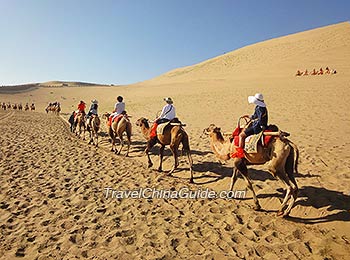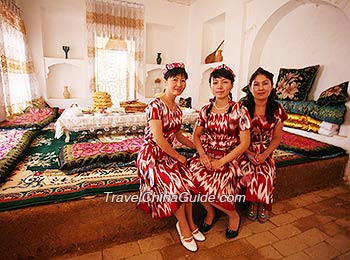 Basic Facts:
Basic Facts:
Chinese Name: 丝绸之路
Chinese Pinyin: Sī Chóu Zhī Lù
English Translation: Silk Road
Length: 4,350 miles (7,000 kilometers) with 2,485 miles (4,000 kilometers) in China
Active: The 2nd Century BC to the 1st Century AD
Location: From Asia to Europe passing through China, Kazakhstan, Kyrgyzstan, Tajikistan, Uzbekistan, Turkmenistan, Afghanistan, Iran, Iraq, Turkey, Greece, and Italy.
Chinese Regions along the Route:
Shaanxi,
Gansu,
Qinghai,
Xinjiang World's Oldest and Longest Trade Route
The term 'Silk Road' in a narrow sense refers to an ancient overland trade route formed in the
Western Han Dynasty (202 BC – 9 AD). This route stretched 4,350 miles from Chang'an (today's
Xi'an) to western China, central Asia, and even to Europe, enabling these regions to have better communications in diplomacy, business and culture.
| Before Western Han Dynasty (202BC - 9AD) | Small-scale business sprouted between central and western China, trading bronze ware, lacquer ware, and jade. |
| 138BC and 119 BC during Western Han | Zhang Qian was twice sent on a diplomatic mission to the Western Regions in China, forming the initial route, which enabled silk to spread and become popular. |
| 16 AD | Western Regions cut off the connection with the central court, and also broke the trade route. |
| Eastern Han Dynasty (25 - 220) | In 73AD, Ban Chao set off on a diplomatic trip to western China and reopened the road, and later his assistant extended this route to the Persian Gulf. In 166AD, the Roman Empire sent an envoy to China. Then ties with the Europe were formed through this road. |
| Sui and Tang (581 – 907) | The route developed into three branches, trading silk, porcelain, and tea. It entered the golden age, together with the maritime route, which even reached Japan. |
| Yuan Dynasty (1271 - 1368) | Italian merchant traveler Marco Polo reached China and introduced the prosperity of this trade route to the whole world through his book. |
| Ming and Qing (1368 - 1911) | It declined due to the rapid development of maritime trade. |
| Modern Times | The trading function fades but it now becomes a tourist route with many historical attractions along the way. |
A World Cultural Heritage Declared by Three Countries
'Silk Roads: the Routes Network of Chang'an – Tianshan Corridor' was successfully inscribed in the World Heritage List in 2014. It was the first multinational application ever, declared by Kazakhstan, Kyrgyzstan, and China.
Why is it called 'Silk' Road?
China was the first country in the world to breed silkworms and produce
silk fabric. This craft skill reached a fairly advanced level in the
Zhou Dynasty (1046 – 256 BC). As the major export to Europe, and being the representative handicraft of this ancient country, 'silk' was used to name this great route by German geographer, Ferdinand von Richthofen.
European Nobilities' Fascination with Silk
China's silk fabric was introduced into western countries through this old trade route. People were unfamiliar with this product at the beginning, and made many guesses at how it was produced. According to the record, the idea that silk was picked from trees was widely accepted by folks in Europe. Clothes made of this fabric were always best sellers, and were considered a social status symbol. Even the gorgeous Egyptian queen, Cleopatra, was also a big fan of the silk. This fascination led to an increasing demand for this product, and promoted the development of this trading route.
Traversing Vast Mountains and Deserts in West China
In fact, more than half of this 4,350-mile route lay within China. It traversed different landforms: lofty mountains, wide prairies, and arid deserts. Horses and camels were the commonly used means of transport. Many sites of ancient cities and palaces can be seen along the way. Buddhism was introduced into China through the Silk Road. So, Buddhist stone grottoes and temples are another highlight of this route.
 |
| Beautiful Uygur Girls |
Diversified Ethnic Customs and Arts of Xinjiang
The western section of the route within China crossed through the Xinjiang Uygur Autonomous Region. This area incorporates several
ethnic groups, with
Uygur as the majority. Distinctive ethnic architectures and customs here have a totally different flavor from those of the central plain. Unique handicrafts of this region like silk carpets and jade jewelry were popular goods transported through the trade route.
Most Popular Attractions to Travel
This old trade route traversed more than 20 cities from central to western China. Numerous natural landscapes and historical sites are distributed along the way, with the most famous sites as follow:
| Xi'an | Terracotta Army, City Wall, Big Wild Goose Pagoda, the Site of Weiyang Palace, Daming Palace Site |
| Luoyang | Longmen Grottoes, Shaolin Temple, White Horse Temple |
| Lanzhou | Bingling Thousand Buddha Caves, Maiji Caves |
| Jiayuguan | Jiayuguan Pass of Great Wall |
| Dunhuang | Mogao Caves, Yumenguan Pass |
| Turpan | Ancient City of Jiaohe, Ancient City of Gaochang |
| Urumqi | Tianshan Mountains, Heavenly Lake, Xinjiang International Grand Bazaar |
| Aksu | Kizil Thousand-Buddha Caves, Subashi Ruins |
| Kashgar | Kashgar Bazaar |
Why is China called China?
In addition to the popularity facts of the silk, brocade, tea, and herbal medicine, chinaware was also shopping-rush goods trading through this road. Originating in the
Shang Dynasty (17th century – 1046 BC), chinaware has been a distinctive handicraft of China. The workmanship peaked in the Tang Dynasty. At that point, this product began to sell to other countries in Asia and Europe and was favored by European nobilities. Then, 'China' became a term used to name this ancient country.
Revival of Modern Silk Road Economic Belt
A 'One Belt One Road' strategy was proposed by Chinese President Xi Jinping in 2013. Based on the ancient trade route, it created the world's longest and most promising economic development zone. With this initiative, the old trade route once again displays its vigor and dynamism to advance economic cooperation and cultural communication among Eurasian countries.
- Last updated on Mar. 01, 2022 -
 Basic Facts:
Basic Facts: